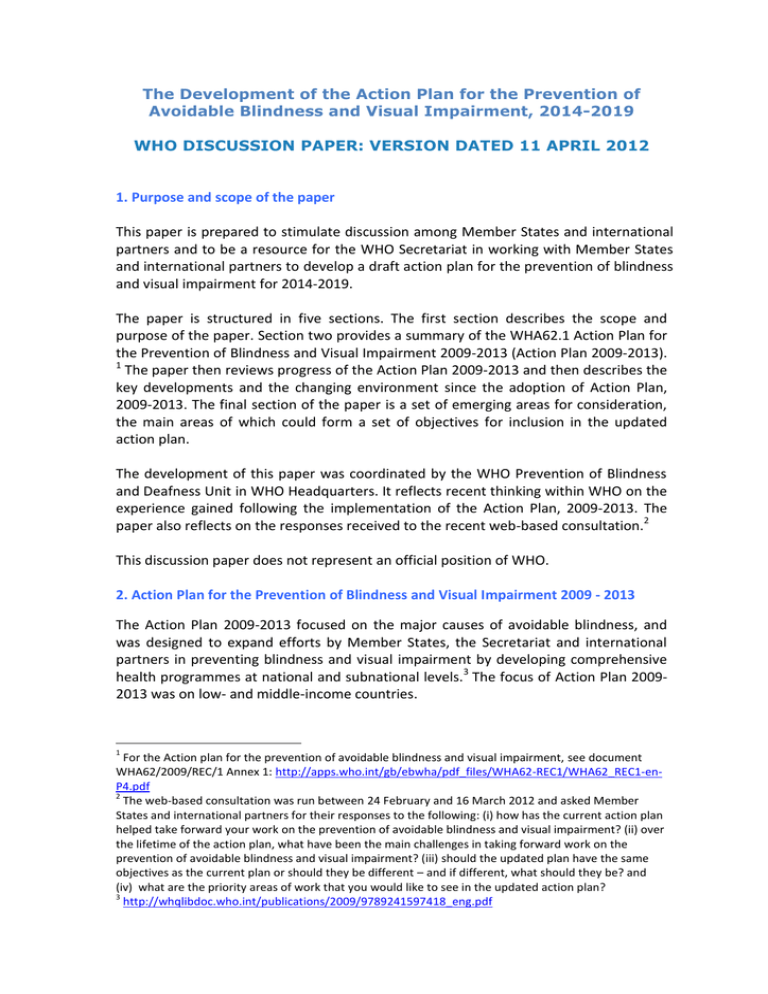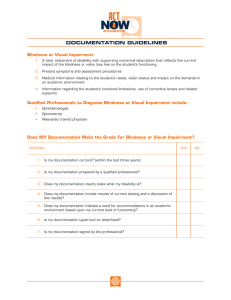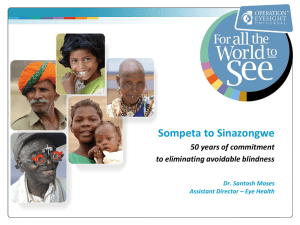
The Development of the Action Plan for the Prevention of
Avoidable Blindness and Visual Impairment, 2014-2019
WHO DISCUSSION PAPER: VERSION DATED 11 APRIL 2012
1. Purpose and scope of the paper
This paper is prepared to stimulate discussion among Member States and international
partners and to be a resource for the WHO Secretariat in working with Member States
and international partners to develop a draft action plan for the prevention of blindness
and visual impairment for 2014-2019.
The paper is structured in five sections. The first section describes the scope and
purpose of the paper. Section two provides a summary of the WHA62.1 Action Plan for
the Prevention of Blindness and Visual Impairment 2009-2013 (Action Plan 2009-2013).
1
The paper then reviews progress of the Action Plan 2009-2013 and then describes the
key developments and the changing environment since the adoption of Action Plan,
2009-2013. The final section of the paper is a set of emerging areas for consideration,
the main areas of which could form a set of objectives for inclusion in the updated
action plan.
The development of this paper was coordinated by the WHO Prevention of Blindness
and Deafness Unit in WHO Headquarters. It reflects recent thinking within WHO on the
experience gained following the implementation of the Action Plan, 2009-2013. The
paper also reflects on the responses received to the recent web-based consultation.2
This discussion paper does not represent an official position of WHO.
2. Action Plan for the Prevention of Blindness and Visual Impairment 2009 - 2013
The Action Plan 2009-2013 focused on the major causes of avoidable blindness, and
was designed to expand efforts by Member States, the Secretariat and international
partners in preventing blindness and visual impairment by developing comprehensive
health programmes at national and subnational levels.3 The focus of Action Plan 20092013 was on low- and middle-income countries.
1
For the Action plan for the prevention of avoidable blindness and visual impairment, see document
WHA62/2009/REC/1 Annex 1: http://apps.who.int/gb/ebwha/pdf_files/WHA62-REC1/WHA62_REC1-enP4.pdf
2
The web-based consultation was run between 24 February and 16 March 2012 and asked Member
States and international partners for their responses to the following: (i) how has the current action plan
helped take forward your work on the prevention of avoidable blindness and visual impairment? (ii) over
the lifetime of the action plan, what have been the main challenges in taking forward work on the
prevention of avoidable blindness and visual impairment? (iii) should the updated plan have the same
objectives as the current plan or should they be different – and if different, what should they be? and
(iv) what are the priority areas of work that you would like to see in the updated action plan?
3
http://whqlibdoc.who.int/publications/2009/9789241597418_eng.pdf
11 April 2012
Discussion paper: development of the action plan for the prevention of avoidable blindness and visual impairment 2014-2019
Action Plan 2009-2013 sets out five objectives. Each one had actions for the
Secretariat, proposed actions for Member States and proposed actions for
international partners. In total there were around 100 sets of actions, some broad and
others more specific.
The five objectives of the 2009-2013 Action Plan
Objective 1: Strengthen advocacy to increase Member States’ political, financial and technical
commitment in order to eliminate avoidable blindness and visual impairment.
Objective 2: Develop and strengthen national policies, plans and programmes for eye health
and prevention of blindness and visual impairment.
Objective 3: Increase and expand research for the prevention of blindness and visual
impairment.
Objective 4: Improve coordination between partnerships and stakeholders at national and
international levels for the prevention of blindness and visual impairment.
Objective 5: Monitor progress in elimination of avoidable blindness at national, regional and
global levels.
3. Progress in implementing the Action Plan 2009-2013
Successes to celebrate…
Action Plan 2009-13 provided a global set of objectives and tasks for addressing
avoidable blindness and visual impairment. This has undoubtedly provided a shared
vision on what needed to be done, and to some extent has clarified roles and
responsibilities. The Action Plan was clear in recognising the emerging public health
challenge of chronic noncommunicable eye disease. But the Action Plan 2009-2013 also
highlighted the unfinished agenda of trachoma and onchocerciasis elimination.
Action Plan 2009-13 has been valuable for advocating resources and political
commitment for investing in eye care provision. In some countries, Action Plan 2009-13
facilitated more effective interaction between the Government and international and
domestic partners, and in some cases did result in an increase in resources provided by
governments and donor agencies. In some countries Action Plan 2009-13 has been
used to guide the development of national prevention of blindness plans and strategies,
and national guidelines and standards for eye care service provision.
Action Plan 2009-13 also provided a mechanism for the WHO Secretariat to report on
its progress in driving forward its work and some of the achievements have been
described in the WHO Secretariat’s report to the Executive Board and World Health
Assembly.4
4
th
A report was submitted to the 130 Executive Board in January 2012
(http://apps.who.int/gb/ebwha/pdf_files/EB130/B130_8-en.pdf) and an updated one has been
submitted to the May 2012 World Health Assembly.
2
11 April 2012
Discussion paper: development of the action plan for the prevention of avoidable blindness and visual impairment 2014-2019
… but despite the above, there have been shortcomings too.
Despite the successes described above, there is little evidence that most low- and
middle-income countries have significantly increased their investment in eye care
services. In particular, it appears that there has been insufficient attention to
integrating eye care into primary health and ensuring strong linkages with the wider
health systems agenda.
Despite considerable political support from Member States and international partners
when Action Plan 2009-13 was adopted by the World Health Assembly, ambitious aims
in Action Plan 2009-13 have not been supported by the necessary resources for its
implementation. The WHO Secretariat costed its own activities at around US$14m over
the five years of the Plan but almost no resources were subsequently identified. Indeed
over the lifetime of the Action Plan staffing in WHO at both headquarters and in the
regions has decreased significantly. 5 A second challenge for Member States and
international partners was that the majority of activities were not costed. As a result,
raising resources in a strategic manner was difficult. A series of meetings for Member
States and international partners organized by the Secretariat and/or others failed to
result in adequate resources to support the tasks set out in Action Plan 2009-13.
Given the resources available, there has been an effort to prioritise tasks and activities.
But on reflection, the breadth and depth of tasks set out in Action Plan 2009-2013,
meant that it was always going to be unrealistic to implement fully. A particular
challenge was that some of the tasks were also difficult to measure.
Alignment of Action Plan 2009-13 with relevant plans and strategies within WHO and
those of other partners was less optimal than it could have been – and as a result it
may be that opportunities for synergies were lost. For example, the linkages with
trachoma and onchocerciasis control programmes were not strong, nor were the links
with the broader noncommunicable disease agenda. In other cases, where these
linkages were identified, for example, with health system strengthening activities (for
example in terms of human resources for health, and access to medicines and
technologies), more work remains to be done. There may also have been missed
opportunities to link disease specific initiatives (for example cataract surgery and
trachoma and onchocerciaisis elimination programmes) with the broader development
of comprehensive eye care systems (e.g. diabetic retinopathy, low vision and refractive
error services). A specific challenge was the time taken to align Action Plan priorities
under the VISION 2020 Global Initiative with those under Action Plan 2009-13.6
5
At the start of Action Plan 2009-13, there were 8.5 full time equivalent (FTE) professional positions
working on the prevention of avoidable blindness and visual impairment in headquarters (2 on
onchocerciaisis, 2 on trachoma, and 4.5 on the broader agenda). In 2012, there are 3.5 FTE professional
positions (2 on onchocerciaisis, 0.5 on trachoma and 2.0 on the broader agenda). At the regional level,
there were FTE positions in 5 regions at the start of Action Plan 2009-2013. In 2012, there are FTE
positions in 4 regions.
6
VISION 2020 is the global initiative for the elimination of avoidable blindness, a joint programme of
WHO and the International Agency for the Prevention of Blindness with an international membership of
NGOs, professional associations, eye care institutions and corporations.
(http://www.vision2020.org/main.cfm.)
3
11 April 2012
Discussion paper: development of the action plan for the prevention of avoidable blindness and visual impairment 2014-2019
Although the Executive Board and World Health Assembly report provides a
mechanism for the WHO Secretariat to report on its activities, there has been no
effective mechanism in place for Member States and international partners to report
on their progress.
4. Changing landscape: the environment in which the 2014-2019 Action Plan is being
developed
There are a number of areas where the landscape has changed since the adoption of
Action Plan 2009-13. Some of the key areas are outlined below.
a. Political
The adoption of the Political Declaration on NCDs at the United Nations General
Assembly in September 2011 focused on cardiovascular diseases, cancer, diabetes and
chronic respiratory disease alongside tackling the main risk factors (tobacco use,
alcohol).7 Stepping up action in these areas may offer the opportunity to add eye
disease control components and eye diseases were mentioned in the Political
Declaration, alongside other conditions such as oral health and kidney disease.
Increasingly leaders are considering adopting innovative multidisciplinary responses to
control chronic eye diseases, for example by:
Enhancing key stakeholders’ understanding and contribution to the
multidisciplinary approach service provision for addressing chronic eye diseases;
and
Bringing leaders from different sectors together to form dynamic, results-oriented
partnerships.
With regards to trachoma and onchocerciasis elimination, there has been ever greater
political commitment to eliminate these two diseases. In January 2012, the London
Declaration on Neglected Tropical Diseases announced a new, coordinated push to
accelerate progress toward eliminating or controlling 10 neglected tropical diseases
(including trachoma and onchocerciaisis) by the end of the decade.8 At the same time,
WHO published a roadmap that laid out the next steps in relieving and, in many cases,
finally ending the misery caused by these ancient diseases of poverty.9
Recent research has described experience in Member States in securing the political
support of high level decision-makers in prioritizing investment in eye health.
b. Public health impact
7
http://www.un.org/ga/search/view_doc.asp?symbol=A%2F66%2FL.1&Lang=E
www.who.int/neglected_diseases/London_Declaration_NTDs.pdf
9
WHO. Accelerating work to overcome the global impact of neglected tropical diseases – a roadmap for
implementation. 2012. whqlibdoc.who.int/hq/2012/WHO_HTM_NTD_2012.1_eng.pdf
8
4
11 April 2012
Discussion paper: development of the action plan for the prevention of avoidable blindness and visual impairment 2014-2019
In 2011, WHO published updated data on blindness and visual impairment. These data
describe the significant global burden of blindness and visual impairment with an
estimated 285 million people visually impaired , of whom 39 million are blind. The main
cause of blindness was cataract (51%) and the major causes of visual impairment are
uncorrected refractive errors (43%) and cataract (33%). The poor and least educated
communities are the most affected. Overall, 80% of blindness and visual impairment is
estimated as avoidable.
c. Public health response
Provision of effective and accessible eye care services is the key to controlling blindness
and visual impairment. Public health interventions for preventing and treating the
major causes of blindness and visual impairment remain much the same as when the
Action Plan was published. Many remain highly cost effective, for example, cataract
surgeries, trachoma, and the provision of eye glasses. However, over the last five years
there has been increased interest in the use of telemedicine for diagnosis, treatment
and to support education and skill transfer. To guide public health responses in
addressing chronic noncommunicable eye diseases, the Secretariat is preparing a
Technical Series Report to be made available in early 2013.
In 2011, a global roadmap for the control, elimination and eradication of neglected
tropical diseases (including trachoma and onchocerciasis) was launched. The roadmap
sets targets for 2012–2020.
There is ever increasing recognition that comprehensive eye care services need to
become integrated with primary health care and wider health systems development.
This is especially important, for example, for preventing visual impairment from
diabetes retinopathy, retinopathy of prematurity and indeed for the prevention and
management of almost all causes of avoidable blindness and visual impairment. The
last few years have seen an ever increasing focus on health systems and as part of this,
the benefits that come from integrating programmes. There is potential to streamline
health promotion for eye care alongside wider health promotion initiatives, such as
preventing tobacco use and a healthy diet. Multisectoral action is also crucial for
preventing a range of chronic noncommunicable eye conditions (e.g. vision loss
associated with diabetes, prematurity, as well as accidents and violence) as well as
trachoma and onchocerciasis. A recent discussion paper for consultation looks at this
for NCDs in more detail.10
Through the establishment of the Global Health Observatory, there is the opportunity
to monitor better the prevalence of eye disease and interventions (for example
cataract services and human resources for eye health) using an agreed set of indicators.
d. Partnerships
In October 2010, WHO met with international partners to review ten years of the
VISION 2020 Global Initiative. A strategic review resulted in aligning workstreams
between the Global Initiative and Action Plan 2013-2019.
10
WHO Discussion Paper. Effective approaches for strengthening multisectoral action for NCDs.
http://www.who.int/nmh/events/2012/consultation_march_2012/en/index.html
5
11 April 2012
Discussion paper: development of the action plan for the prevention of avoidable blindness and visual impairment 2014-2019
Partnerships for eliminating trachoma and onchocerciasis (The WHO Alliance for
Global Elimination of Trachoma by the Year 2020 and the regional onchocerciasis
programmes) have being strengthened by the recent global neglected tropical disease
elimination efforts described above.
e. Financial
In the current financial climate, a major challenge is to ensure that countries and their
partners are investing adequately in the most cost-effective interventions. A key issue
is to ensure that ministers of finance and health and their development partners
mobilize adequate, predictable and sustained financial resources and include the
prevention of avoidable blindness and visual impairment in development cooperation
agendas and initiatives.
Over the last few years, there has been increasing discussion around raising additional
resources for health through innovative financing. Following the 2009
recommendations of the High-Level Task Force on Innovative Financing, the principles
of a global levy on tobacco products have been developed. The 2010 WHO World
Health Report subsequently highlighted innovative financing as a key way of
supplementing national health budgets, whether directly in countries or via global
pooled mechanisms. Overall, noncommunicable diseases, including chronic eye disease
financing has been relatively absent from the global innovative financing for health
debate but national examples do exist, for instance, via the implementation of National
"sin" taxes to finance national health programmes. Fiscal policy options include
taxation for products such as tobacco and alcohol, and potentially for foods that are
unhealthy, as well as consideration of subsidies and incentives.
5. Key issues emerging and suggested agenda for the action plan 2014-2019
In the light of this report, four areas have been identified below that may be useful for
Member States and international partners to explore as they support the WHO
Secretariat in developing the updated action plan. Although not exhaustive, the areas
and the issues raised may provide a useful framework for thinking about priorities for
the 2014-2019 Action Plan. These areas are followed by a possible set of prerequisites,
all potentially important for supporting the four areas. The experience with Action Plan
2009-2013 suggests that it would be helpful if the objectives and actions of the draft
2014-2019 Action Plan fit within a logical framework and that the impact of actions and
activities can be measured. A particular challenge is to be able implement a sufficiently
ambitious action plan in light of the decrease in the Secretariat staff that is described
on page 3.
1) Measuring the magnitude of vision loss
In all countries a priority is to assess the magnitude and causes of blindness and visual
impairment and changes over time. A standardized approach to periodic data
collection needs to be adopted and implemented.
6
11 April 2012
Discussion paper: development of the action plan for the prevention of avoidable blindness and visual impairment 2014-2019
2) Strong health systems to reduce the burden of visual impairment
Developing and strengthening national policies, plans and programmes for the
prevention of blindness and visual impairment is critical. Although a number of eye
disease programmes have had considerable success, there remains the need to even
better integrate eye diseases control programmes into wider health care delivery
systems, especially within primary health care. Strengthening comprehensive eye
health services and wider health service delivery needs to go hand in hand. Examples
include human resources, financial resource allocation, effective engagement with the
private sector and social entrepreneurship, and paying attention to vulnerable
communities. There are an ever-increasing number of countries with experience in
developing and implementing effective eye health services. These experiences need to
be better documented and disseminated.
Strengthening the understanding on the most cost-effective tools for scaling up
national responses to eye care is also essential. There is more work that is needed in
this area, especially on the costs of a national comprehensive eye care package that
integrates into the wider health system.
Despite the focus of Action Plan 2009-2013 on the control of the causes of blindness
and visual impairment, there might be opportunities to broaden the scope of all areas
of prevention (primary, secondary and tertiary). The challenge is to be sufficiently
ambitious and broad but at the same time experience has demonstrated that resources
are likely to be limited and that the 2014-2019 Action Plan needs to be extremely wellfocused.
3) Advancing multisectoral action
Elimination of avoidable blindness is significantly dependent on the progress of other
global health and development agendas, such as the provision of clean water and
sanitation. Where appropriate, eye health should therefore be included into broader
noncommunicable and communicable disease frameworks, with the identification of
appropriate interventions to contribute to poverty eradication. Although there are a
limited number of proven risk factors for the major causes of blindness, those
supported by evidence (e.g. diabetes mellitus, smoking, premature birth, rubella,
vitamin A deficiency) need to be addressed where appropriate through multisectoral
interventions. A major challenge will be to see how the vision loss agenda is
incorporated into wider health policies and strategies and development (including
post-MDG) initiatives.
4) Monitoring and evaluation
Setting national targets with clear monitoring mechanisms is a priority for measuring
the outcomes of interventions and the effective delivery of eye care delivery services. It
is important that such approaches are integrated into national health information
systems and that data are collated at regional and global levels.
To drive the above areas forward, there are a number of prerequisites. Three are
identified as follows:
7
11 April 2012
Discussion paper: development of the action plan for the prevention of avoidable blindness and visual impairment 2014-2019
strong partnerships both nationally and internationally, with plans and
programmes that are aligned;
adequate and sustainable financing; and
research and development.
The principles of effective global health partnerships are as applicable to eye health as
other areas.11 It may be helpful for the 2014-2019 Action Plan to be seen as the overall
roadmap for the activities of international partners in preventing avoidable blindness
and visual impairment to ensure focus and maximize the use (and impact) of resources.
In terms of financing, there remains considerable work that is required in articulating
the amount of funding required at global and national levels for tackling eye diseases (a
global and national “price tag”) and then being able to advocate for these resources
effectively. Using the recent work done on how to engage with decision-makers to
secure resources for eye health (page 4) is important.
Critical is a robust operational research and development framework to underpin any
action plan, and the 2014-2019 Action Plan is likely to be no different. Research and
development is needed to progress in all the areas above and a set of costed priorities
should be included. Examples could include: access to eye health care serices, how
best to integrate human resources development within the health sector, and how to
most effectively finance eye services in low- and middle-income settings. Other
priorities have been described in a report of a meeting of international partners in
2010.12
oooOOOooo
11
Discussion Paper. Lessons learned from existing multisectoral partnerships that may inform the global
response to NCDs. http://www.who.int/nmh/events/2012/consultation_march_2012/en/index.html
12
Porcino A. Workshop Report: A VISION 2020 Workshop on Research for Global Blindness Prevention.
RPR Consulting, 2010.
8
11 April 2012
Discussion paper: development of the action plan for the prevention of avoidable blindness and visual impairment 2014-2019
Disclaimer
This WHO Discussion Paper does not represent an official position of the World Health
Organization. It is a tool to explore the views of interested parties on the subject
matter. References to international partners are suggestions only and do not constitute
or imply any endorsement whatsoever of this discussion paper.
The World Health Organization does not warrant that the information contained in this
discussion paper is complete and correct and shall not be liable for any damages
incurred as a result of its use.
The information contained in this discussion paper may be freely used and copied for
educational and other non-commercial and non-promotional purposes, provided that
any reproduction of the information be accompanied by an acknowledgement of WHO
as the source. Any other use of the information requires the permission from WHO,
and requests should be directed to World Health Organization, Department of Chronic
Diseases and Health Promotion, 20 Avenue Appia, 1211 Geneva 27, Switzerland.
The designations employed and the presentation of the material in this discussion
paper do not imply the expression of any opinion whatsoever on the part of the World
Health Organization concerning the legal status of any country, territory, city or area or
of its authorities, or concerning the delimitation of its frontiers or boundaries. The
mention of specific companies or of certain manufacturers’ products does not imply
that they are endorsed or recommended by the World Health Organization in
preference to others of a similar nature that are not mentioned. Errors and omissions
excepted, the names of proprietary products are distinguished by initial capital letters.
All reasonable precautions have been taken by the World Health Organization to verify
the information contained in this discussion paper. However, this discussion paper is
being distributed without warranty of any kind, either expressed or implied. The
responsibility for the interpretation and use of the presentation lies with the reader. In
no event shall the World Health Organization be liable for damages arising from its use.
© World Health Organization, 2012. All rights reserved.
The following copy right notice applies: www.who.int/about/copyright
9




